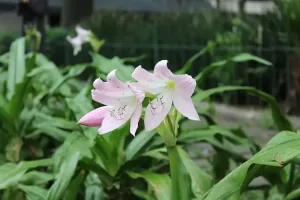If you’re a gardener looking to add some beauty to your outdoor space, you may want to consider growing Azucena flowers. But what is Azucena flower? These flowers, also known as lilies, are known for their elegant beauty, unique fragrance, and wide range of colors. From the traditional Madonna Lily to the exotic Agave Amica, Azucena flowers are a great addition to any garden.
If the name Azucena is throwing you off guard or maybe it’s the first time you have heard this name. Don’t worry as in this article we will explain everything you need to know about Azucena flowers
So, let’s dive in and discover the wonderful world of Azucena flowers!
What is Azucena Flower?
Azucena flowers, also known as lilies, are bulbous perennial plants belonging to the genus Lilium. Azucena flower is a type of flowering plant known for its trumpet-shaped blooms that come in a range of colors including white, pink, red, and yellow.
The name “Azucena” is derived from the Spanish word for “lily” and is often used to refer to various types of lilies in the Lilium genus. However, the term “Azucena” can also refer specifically to the Madonna lily (Lilium candidum), which is known for its white, fragrant blooms and has been cultivated for centuries for its ornamental and medicinal uses.
While the term “Azucena” is often used interchangeably with the term “lily,” it can also refer to other plants with similar trumpet-shaped flowers, such as the Azucena de Rio (Hippeastrum petiolatum), Agave Mica (Polianthes tuberosa), and Field Lily (Crinum angustifolium), which are also commonly referred to as Azucena flowers.
In Spanish, the word “Azucena” also translates to “sweetness” or “purity,” which reflects the pure, white blooms of the Madonna lily and other white lilies that are often associated with spiritual purity and innocence. However, the term can also be used to describe any type of trumpet-shaped flower, regardless of its color or symbolism.
So, if you come across the term “Azucena” while researching different types of flowering plants, it’s important to note that it can refer to several different species of lilies and other trumpet-shaped flowers.
The Appearance of Azucena Flower
When it comes to appearance, Azucena flowers are simply breathtaking. The trumpet-shaped flowers are composed of six petals that gracefully arch outwards from a central bell-shaped tube.
They come in a range of colors, including white, pink, yellow, orange, and red. The flowers can grow up to 6 inches in diameter and can reach up to 3 feet in height, making them a stunning addition to any garden.
Characteristics of Azucena Flower
Here are a few key things to know about Azucena flowers:
- Varieties: There are many different types of Azucena flowers, ranging in color from pure white to deep red. The most popular varieties of Azucena flowers are Trumpet lilies.
- Habitat: Azucena flowers are native to the temperate regions of the northern hemisphere, including parts of Europe, Asia, and North America.
- Symbolism: Azucena flowers have long been associated with purity, innocence, and beauty. In many cultures, they are used in religious ceremonies, weddings, and other special occasions.
- Uses: Azucena flowers are often used for decorative purposes, either in cut flower arrangements or planted in gardens. They are also sometimes used in perfumes and other fragrances.
Origins of Azucena Flowers
Azucena flowers have a rich history and are a popular choice among gardeners worldwide. Here’s what you need to know about their origins:
Ancient Greek and Roman times
Azucena flowers have been around for thousands of years and were widely used in ancient Greek and Roman cultures. The Greeks associated the Azucena with the goddess Hera, the queen of gods, and the Romans saw it as a symbol of purity.
Middle Ages
During the Middle Ages, the Azucena became a symbol of the Virgin Mary’s purity and was often depicted in religious paintings and stained glass windows.
Today
Nowadays, Azucena flowers are grown all over the world and have become a popular choice for gardeners due to their stunning beauty and ease of cultivation.
Types of Azucena Flowers
Azucena flowers come in a variety of shapes, sizes, and colors. Here are some of the most popular types of Azucena flowers:
1. Madonna Lily (Lilium candidum)
The Madonna Lily is one of the most popular types of Azucena flowers. It’s a classic flower that has been around for centuries and is known for its pure white color and sweet fragrance. The Madonna Lily blooms in the summer and can grow up to 3 feet tall.
2. Azucena de Rio (Hippeastrum petiolatum)
The Azucena de Rio is a striking red Azucena flower that blooms in the winter. It’s native to South America and can grow up to 2 feet tall. This flower is a great addition to any garden, especially during the winter months when other plants may not be blooming.
3. Agave Amica (Polianthes tuberosa)
The Agave Amica is a unique type of Azucena flower that is native to Mexico. It has long, slender stems that can grow up to 3 feet tall and produce fragrant white flowers. The Agave Amica blooms in the summer and is a popular choice for cut flower arrangements. This flower is also sometimes knowns as Nardos Flower.
4. Field Lily (Crinum angustifolium)
The Field Lily is a beautiful Azucena flower that is native to the southern United States. It has large, trumpet-shaped flowers that come in various colors, including white, pink, and red. The Field Lily blooms in the summer and can grow up to 4 feet tall.
5. Easter Lily (Lilium longiflorum)
The Easter Lily is a popular Azucena flower often associated with the Easter holiday. It has large, fragrant white flowers that bloom in the spring and can grow up to 3 feet tall. The Easter Lily is a great choice for both outdoor gardens and indoor arrangements.
These are just a few of the many types of Azucena flowers available. Each type has its unique characteristics and can add beauty and fragrance to any garden.
How to Grow Azucena Flowers
Growing Azucena flowers is relatively easy, but it does require some care and attention. Here are some tips for growing healthy and vibrant Azucena flowers:
1. Planting
- Choose a sunny spot: Azucena flowers require at least 6 hours of sunlight per day, so choose a spot that receives plenty of direct sunlight.
- Soil preparation: Azucena flowers prefer well-draining soil with a slightly acidic pH level. You can add organic matter like compost or peat moss to improve the soil’s quality.
- Planting depth: Plant the bulbs at a depth of about 3 times their diameter. For example, if a bulb is 2 inches in diameter, plant it 6 inches deep.
2. Watering
- Water regularly: Azucena flowers require regular watering to keep the soil moist but not waterlogged.
- Avoid overwatering: Overwatering can lead to root rot, so be careful not to water too frequently or too heavily.
- Mulch: Applying a layer of mulch around the base of the plants can help to retain moisture and prevent weeds from growing.
3. Fertilizing
- Fertilize regularly: Azucena flowers benefit from regular fertilization, especially during their growing season.
- Use a balanced fertilizer: Choose a fertilizer with equal parts nitrogen, phosphorus, and potassium. Apply the fertilizer according to the manufacturer’s instructions.
4. Maintenance
- Deadheading: Remove spent flowers to encourage the plant to produce more blooms.
- Pest control: Watch out for pests like aphids and spider mites. If you notice an infestation, use an appropriate pesticide or insecticidal soap to control the problem.
- Staking: Some Azucena flowers, like the Madonna Lily, can grow tall and may require staking to keep them from toppling over.
By following these simple tips, you can grow healthy and vibrant Azucena flowers that will add beauty and fragrance to your garden. Remember to pay attention to the specific needs of each type of Azucena flower and adjust your care accordingly.
Uses of Azucena Flowers
Azucena flowers are not just beautiful to look at, they also have a range of uses that make them a popular choice among gardeners and florists. Here are some of the most common uses of Azucena flowers:
Ornamental
Azucena flowers are popular among gardeners for their striking beauty and fragrance. They make a great addition to any garden, whether planted in beds or grown in pots. Azucena flowers can also be used to create beautiful floral arrangements and bouquets due to their long stems and large blooms.
Medicinal
In traditional medicine, Azucena flowers have been used to treat a variety of ailments, including respiratory issues, digestive problems, and skin conditions. The bulbs of some Azucena varieties, such as the Polianthes tuberosa, are also used to make perfumes and essential oils.
Culinary
Some Azucena varieties are edible and are used in cooking in various parts of the world. The Madonna lily, for example, is used in Italian cuisine to make a sweet dessert known as “pasta reale,” while the bulbs of the Polianthes tuberosa are used in Indian and Middle Eastern cuisine to flavor rice dishes and sweets.
Religious
As mentioned earlier, Azucena flowers have been associated with religious symbolism for centuries, particularly in Christianity. They are often used in religious ceremonies, such as weddings and funerals, to represent purity and resurrection.
Whether you’re looking to add beauty to your garden, treat a medical ailment, or incorporate Azucena flowers into your cooking or religious practices, there are plenty of ways to make use of these versatile and stunning flowers.
Care Tips for Azucena Flowers
Azucena flowers are known for their beauty and fragrance, but they also require proper care to thrive. Here are some essential care tips to keep in mind for healthy and vibrant Azucena flowers.
1. Soil Requirements
Azucena flowers thrive in well-draining soil with a pH level of 6.0 to 6.5. The soil should be moist but not waterlogged, and it should be enriched with organic matter such as compost or well-rotted manure. If your soil is heavy or poorly drained, consider adding sand or perlite to improve its texture.
2. Watering
Azucena flowers need regular watering to keep the soil moist. However, overwatering can lead to root rot, so it’s essential to strike a balance. Water the plants deeply once a week, allowing the water to soak in, and then let the soil dry out slightly before watering again. During hot, dry weather, you may need to water more frequently.
3. Sunlight
Azucena flowers thrive in full sun or partial shade, depending on the variety. Make sure to plant them in a spot that receives at least six hours of sunlight a day, but avoid exposing them to intense afternoon sun, which can scorch the leaves and flowers.
4. Fertilization
Azucena flowers require regular fertilization to promote healthy growth and blooming. Use a balanced fertilizer with equal parts nitrogen, phosphorus, and potassium. Apply the fertilizer every four to six weeks during the growing season, following the instructions on the label.
5. Pruning
Pruning is essential to keep Azucena flowers healthy and promote blooming. Deadhead the flowers regularly by removing spent blooms to encourage the plant to produce new ones. Also, trim back any yellow or brown leaves to prevent disease and pest problems.
6. Pest and Disease Control
Azucena flowers can be susceptible to pests and diseases, so it’s essential to keep an eye out for any signs of trouble. Common pests include aphids, spider mites, and thrips, while diseases such as powdery mildew and botrytis can affect the leaves and flowers. Treat any issues promptly with insecticidal soap or fungicides, following the instructions on the label.
By following these care tips, you can ensure that your Azucena flowers thrive and provide you with beautiful blooms for years to come.
FAQs
Here are some commonly asked questions about Azucena flowers:
Conclusion
In conclusion, Azucena flowers have a rich history and cultural significance, with various types and varieties that offer unique beauty and fragrances. From the Madonna Lily to the Agave Mica, these flowers have been used for centuries in traditional medicine, religious ceremonies, and home decor.
While they may require some extra care and attention, growing Azucena flowers can be a rewarding experience for any gardener. Whether you’re looking to brighten up your garden or add some elegance to your home, Azucena flowers are a great choice.
So go ahead and add some Azucena flowers to your garden or home today. You won’t regret it!








